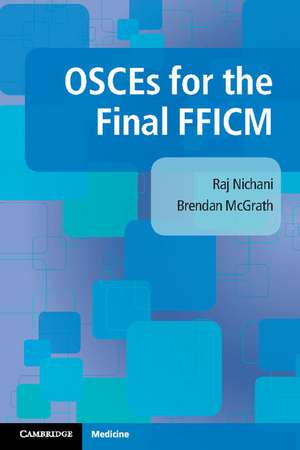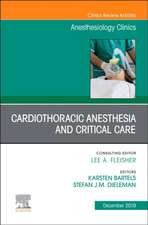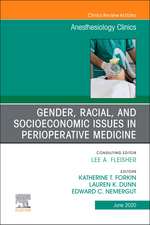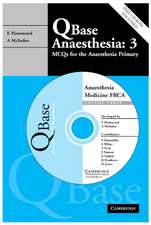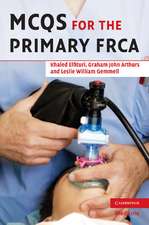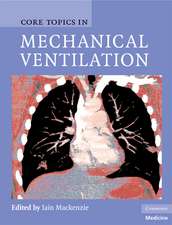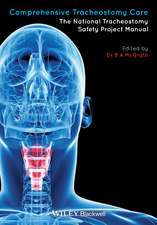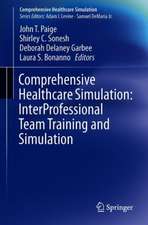OSCEs for the Final FFICM
Autor Raj Nichani, Brendan McGrathen Limba Engleză Paperback – 27 iul 2016
Preț: 379.35 lei
Preț vechi: 399.32 lei
-5% Nou
Puncte Express: 569
Preț estimativ în valută:
72.59€ • 75.79$ • 60.08£
72.59€ • 75.79$ • 60.08£
Carte disponibilă
Livrare economică 15-29 martie
Livrare express 01-07 martie pentru 37.69 lei
Preluare comenzi: 021 569.72.76
Specificații
ISBN-13: 9781107579453
ISBN-10: 1107579457
Pagini: 310
Ilustrații: 97 b/w illus. 29 colour illus. 58 tables
Dimensiuni: 157 x 234 x 15 mm
Greutate: 0.54 kg
Editura: Cambridge University Press
Colecția Cambridge University Press
Locul publicării:New York, United States
ISBN-10: 1107579457
Pagini: 310
Ilustrații: 97 b/w illus. 29 colour illus. 58 tables
Dimensiuni: 157 x 234 x 15 mm
Greutate: 0.54 kg
Editura: Cambridge University Press
Colecția Cambridge University Press
Locul publicării:New York, United States
Cuprins
Part I. Data Interpretation: 1. Acid base; 2. Methaemoglobin; 3. Infective diarrhoea and toxic megacolon; 4. Major burn; 5. Ruptured hemidiaphragm; 6. Post cardiac arrest; 7. Necrotising fasciitis; 8. ARDS; 9. Stridor; 10. Hyponatraemia; 11. Chest drain in liver; 12. Interpretation of pulmonary function tests; 13. Serotonin syndrome; 14. Propofol infusion syndrome; 15. Guillain-Barré syndrome; 16. Epidural management; 17. Panton-Valentine leukocidin (PVL) MRSA pneumonia; 18. Surviving (urological) sepsis; 19. Ventilator associated pneumonia; 20. Refeeding syndrome; 21. Acute coronary syndrome and papillary muscle rupture; 22. TTP/HUS; 23. Subarachnoid haemorrhage; 24. Post oesophagectomy anastomotic leak; 25. Pulmonary embolism; 26. Heparin-induced thrombocytopenia; 27. Brainstem death; 28. Tricyclic overdose; 29. Chest pain assessment; 30. Intra abdominal hypertension; 31. Selective decontamination of the digestive tract; 32. Bone marrow transplant; 33. Acute kidney injury; 34. Broncho-pleural fistula; 35. Myasthenia gravis; 36. RV infarct; 37. Rhabdomyolysis; 38. Cerebrovascular accident; 39. Acute leukaemia; 40. Diabetic keto acidosis; 41. Failure to wean; 42. Pleural effusion; 43. ICU follow up clinic anaemia; 44. Acute liver failure; 45. Cirrhosis with upper GI bleeding; 46. Sedation and sedation scoring; 47. Encephalitis, epilepsy and MRI scans; 48. Acute renal failure in a HIV positive man; 49. Digoxin toxicity and cardiac pacing; 50. Acute pancreatitis; 51. Cortisol and thyroxine in the critically ill; 52. TEG and major haemorrhage; 53. Poisoning; 54. ECG interpretation; 55. CXR interpretation; Part II. Equipment: 1. Arterial lines; 2. Tracheostomy weaning and communication; 3. Bronchoscopy; 4. Cooling devices; 5. PA catheter; 6. Naso gastric tubes; 7. High flow nasal cannula; 8. Cardiac output technologies; 9. Catheter related blood stream infection and vancomycin-resistant enterococcus; 10. Spinal needles; 11. Capnography; 12. Patient transfer; 13. Tracheostomies; 14. Central lines; 15. Haemofiltration; 16. Intra aortic balloon pump; Part III. Ethics and Communication: 1. Anaphylaxis; 2. Pulmonary embolism; 3. Malignant hyperpyrexia; 4. Organ donation; 5. End of life care; 6. Muscular dystrophy; 7. Delirium; 8. Deterioration post discharge; 9. Consent for tracheostomy; 10. Blood transfusion; 11. Alcoholic liver disease; 12. Long QT; Part IV. Resuscitation: Introduction; 1. Displaced airway; 2. Child submersion; 3. Child with seizures; 4. Bleeding trauma with head injury; 5. Asthma; 6. Pregnancy and VF arrest; 7. Chest opening on the ICU; 8. Paediatric sepsis; 9. Tracheostomy emergency; 10. Anaphylaxis.
Notă biografică
Descriere
Comprehensive coverage of key topics for the FFICM OSCE examination, based on actual exam questions and modelled to the curriculum.
